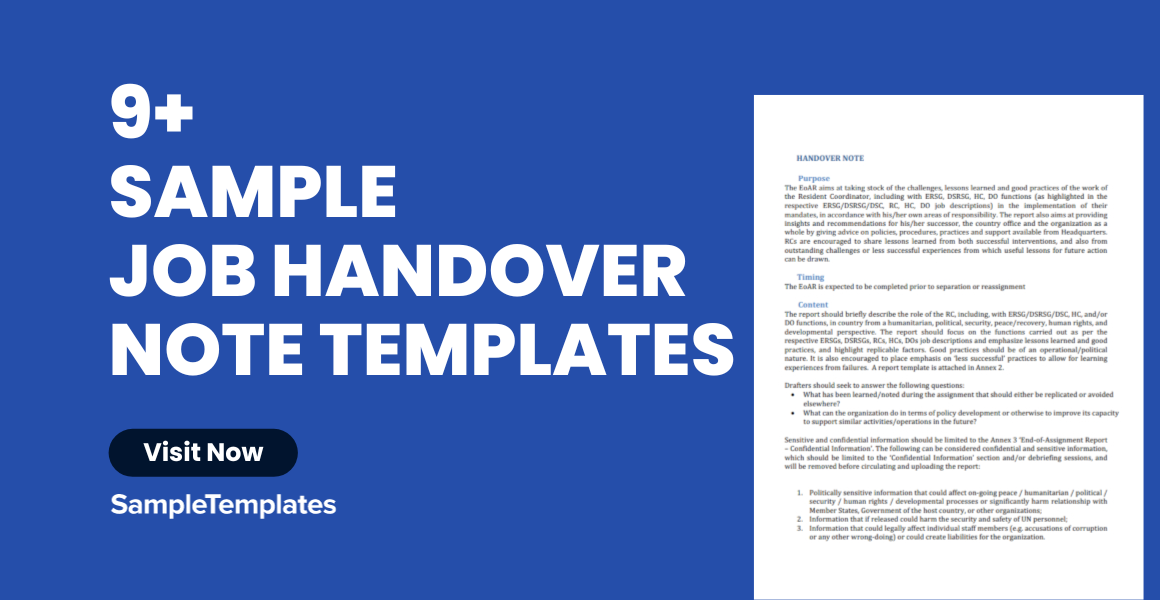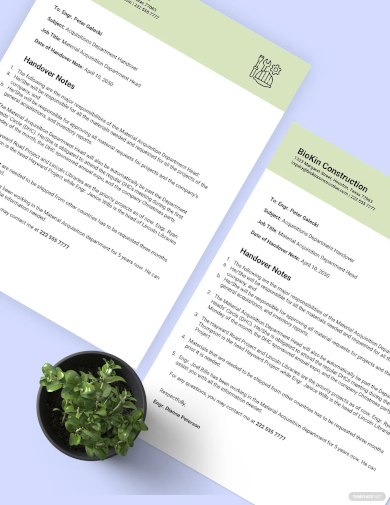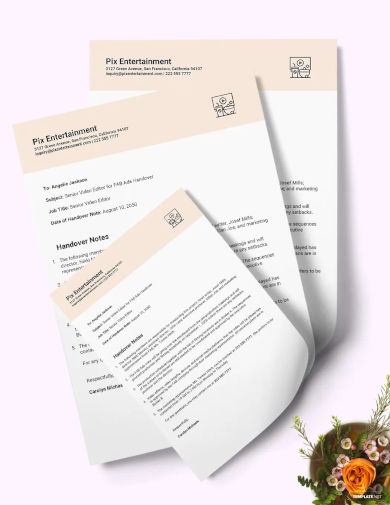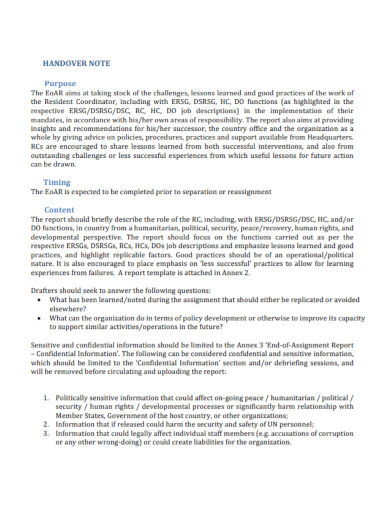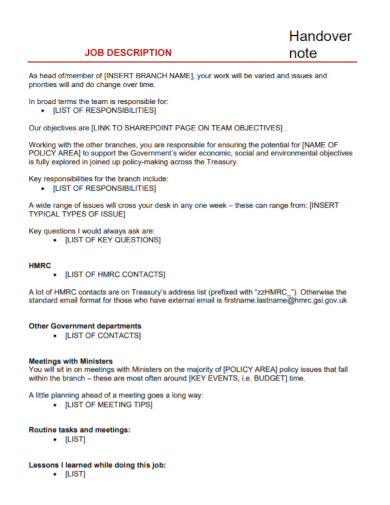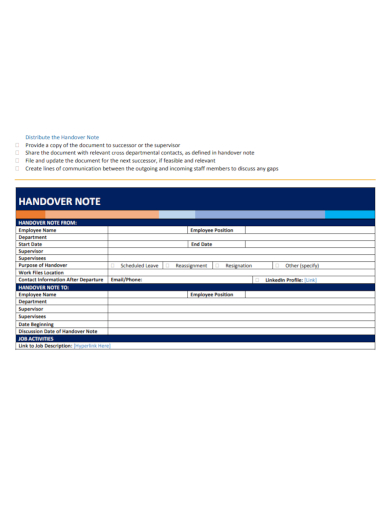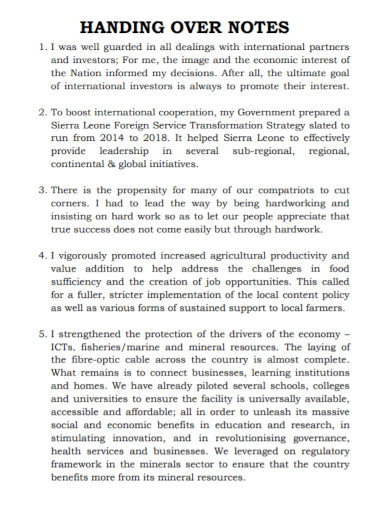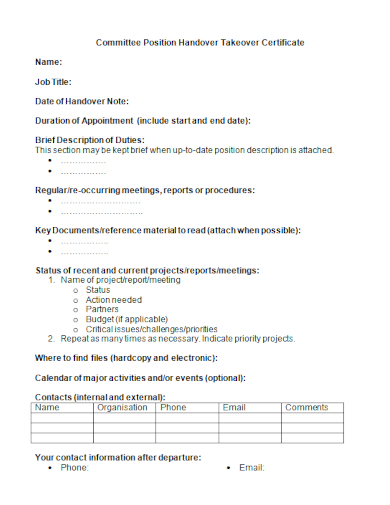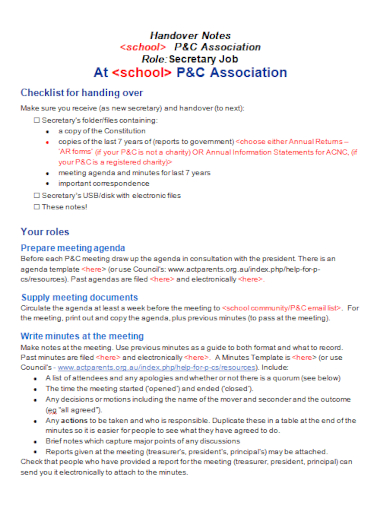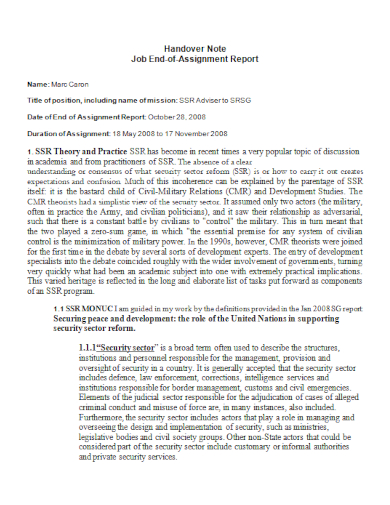Once you decide leaving a particular job analysis, one of the things that might enter into your mind is how you are going to hand over the position to the next person. Handovers play an essential role and process in every aspect of an organization. Whenever one of the employees leave a position for whatever reason it may be, they should always execute the proper way of a handover to ensure a smooth transition of the process. If you are an employer or the manager perhaps, it will be your responsibility to make sure that the incoming employees will receive a detailed handover, may it be coming on board long-term, covering the position for a maternity, or long-service leave.
9+ Job Handover Note Samples
1. Handover Job Note Template
2. Handover Note When Leaving Job Template
3. Basic Job Handover Note Template
What is a Job Handover Note?
Handover notes sample are a type of document that can be created by any staff members who are about to leave their job positions permanently or temporarily, in order to give assistance to the incoming employee who will carry out their duties and responsibilities. It is designed to provide the incoming employee with a proper knowledge and information about the job position so that the transition will become smooth as possible.
Having a good handover note will help the new member of the team to settle into the position easily. It would also be an advantage as they would be feeling more comfortable and confident with the process of their new job. It will be beneficial to other members in the organization as it will provide less disruption with regards to the team work flows and productivity rates. The contents and how lengthy it is will depend on the complexity of the job and for long the job position has been covered for. In case study of a long-term handover, it is always required to have a face-to-face conversation plus a written document.
Four Key Components of a Handover Note
Basically, a comprehensive handover note must have a number of aspects that tells about the job post.
1. Detailed and precise status of the ongoing tasks – this part must have a short but detailed description of the unfinished project and tasks.
2. Upcoming deadline – before emphasizing the dates approaching the deadlines, it is always required to include a short handover note that tells about how urgent the task is. Also, indicate the channel with the team members involved.
3. Forthcoming events – it is always essential to provide a description of the forthcoming events as it allows employees to prepare. The role of the handover note is to capture the exact details pertaining to the occasion.
4. Distinctive roles – it should provide the incoming employee with a comprehensive list of the roles that your job post is involved. This component is ideal only for managerial positions.
4. Job Description Handover Note Template
5. Job Activity Handover Note Template
6. Sample Job Handover Note Template
How do you write a job handover note?
A job handover note is a crucial document that ensures a smooth transition when an employee leaves a position or transitions to a new role within an organization. It serves as a comprehensive guide for the incoming employee, providing them with the necessary information to carry out their duties effectively. Here is a detailed guide on how to write a job handover note:
1. Header and Introduction:
- Begin with a clear header indicating that it is a “Job Handover Note.”
- Introduce yourself and mention your current position.
2. Recipient Details:
- Provide details about the person who will be taking over your responsibilities.
- Include their name, position, and any other relevant information.
3. Job Responsibilities:
- List all your current job responsibilities in a structured manner.
- Clearly outline the tasks, projects, and duties associated with your role.
4. Project Details:
- If applicable, provide details about ongoing projects.
- Mention project statuses, timelines, and key contacts involved.
5. Contact Information:
- Include your contact information in case the new employee has additional questions.
- Provide both email and phone details.
6. Key Stakeholders:
- Identify and list key stakeholders associated with your role.
- Include their names, positions, and any specific details relevant to collaboration.
7. Important Documents:
- Highlight the location of crucial documents.
- Specify where the new employee can find manuals, guidelines, and any procedural documents.
8. Login Credentials:
- If applicable, provide login credentials for relevant systems and accounts.
- Ensure the security of this information by sharing it through a secure channel.
9. Outstanding Tasks:
- Clearly mention any pending or incomplete tasks.
- Provide insights into the status of these tasks and the steps required for completion.
10. Challenges and Solutions:
- Identify potential challenges the new employee might face.
- Suggest solutions or strategies for overcoming these challenges.
11. Transition Timeline:
- Specify the effective date of the handover.
- Outline any specific dates for training sessions or additional support.
12. Acknowledgment Section:
- Include a section where the new employee can acknowledge receiving the handover note.
- Provide space for their signature and the date.
13. Additional Notes:
- Any additional information that could aid the transition can be included here.
- Be concise but comprehensive.
14. Review and Finalization:
- Review the document for completeness and accuracy.
- Ensure that all necessary details are included before finalizing.
15. Distribution:
- Share the handover note with relevant stakeholders, including your supervisor and the incoming employee.
7. Standard Job Handover Note Template
8. Committee Job Handover Certificate Note Template
9. Sample Secretary Job Handover Note Template
10. Job Assignment Handover Note Template
What is the handover process when leaving a job?
Leaving a job is a significant transition that involves various task list and responsibilities to ensure a smooth handover. The handover process is crucial for both the departing employee and the organization to maintain continuity and efficiency. Here’s a comprehensive guide to the handover process when leaving a job:
1. Early Notification:
- Employee’s Responsibility: Notify the employer well in advance about the decision to leave.
- Employer’s Role: Acknowledge the resignation and initiate discussions about the handover process.
2. Preparation for Handover:
- Employee’s Responsibility: Start preparing for the handover process by documenting key responsibilities, tasks, and projects.
- Employer’s Role: Provide support and resources to facilitate the smooth handover.
3. Identification of Key Tasks:
- Employee’s Responsibility: Identify and document all ongoing tasks, project work, and pending assignments.
- Employer’s Role: Collaborate with the employee to understand the critical aspects of their role.
4. Creation of a Handover Plan:
- Employee’s Responsibility: Develop a detailed handover plan outlining the transition of tasks and responsibilities.
- Employer’s Role: Review and provide sample feedback on the handover plan.
5. Communication with Stakeholders:
- Employee’s Responsibility: Inform colleagues, team members, and relevant stakeholders about the impending departure.
- Employer’s Role: Support the employee in communicating the transition to the team and other departments.
6. Documenting Processes and Procedures:
- Employee’s Responsibility: Document standard operating procedures, guidelines, and any other relevant information.
- Employer’s Role: Ensure the accuracy and completeness of the documentation.
7. Knowledge Transfer Sessions:
- Employee’s Responsibility: Conduct knowledge transfer sessions with team members to share insights and answer queries.
- Employer’s Role: Encourage and facilitate knowledge transfer sessions.
8. Update Contact Information:
- Employee’s Responsibility: Provide updated contact information to colleagues for any future queries.
- Employer’s Role: Update internal contact directories.
9. Return of Company Property:
- Employee’s Responsibility: Return any company-owned property, such as laptops, access cards, and other assets.
- Employer’s Role: Verify the return of company property and update inventory records.
10. Finalizing Outstanding Tasks:
- Employee’s Responsibility: Ensure the completion or handover of all outstanding tasks.
- Employer’s Role: Monitor and provide assistance in completing pending assignments.
11. Exit Interview:
- Employee’s Responsibility: Participate in an exit interview, providing constructive feedback about the organization.
- Employer’s Role: Use the feedback to improve employee experiences and organizational processes.
12. Farewell and Appreciation:
- Employee’s Responsibility: Bid farewell to colleagues and express gratitude for the collaboration.
- Employer’s Role: Express appreciation for the employee’s contributions and wish them well in their future endeavors.
13. Documentation of Handover:
- Employee’s Responsibility: Provide a comprehensive handover document to the employer.
- Employer’s Role: Review and acknowledge the handover document.
14. Finalizing Employment Formalities:
- Employee’s Responsibility: Complete any remaining paperwork or formalities related to employment termination.
- Employer’s Role: Facilitate the necessary administrative processes.
15. Post-Departure Support:
- Employee’s Responsibility: Offer post-departure support to address any queries that may arise.
- Employer’s Role: Provide ongoing support and maintain a positive relationship.
FAQs
Who is required to write a job handover note?
Any staff member of the organization can write a job handover note. The handover note shall be written even if in an instance that the staff member is leaving the position in order to assume new duties and responsibilities within the same office. If it is only a temporary absence with a duration of no longer than a month, the staff member should make an sample agreement with the supervisor if it is still required to write a handover note.
When should you write a handover note?
A handover note should be written and finalized on the week before the staff member will leave the job position. Basically, there is a period of overlap with the one who will replace the staff member. If in the case that this could not be made possible, the staff member should be able to send a handover note to the incoming employee before departing. He or she should be able to supplement the sample note through a phone conversation or via e-mail.
How to effectively write a handover note?
Handover notes should be at a maximum of 3-4 pages. These doesn’t include the attachments. They should be factual and should have a template to use.
Why is handover important?
Handover is important to ensure a seamless transition of responsibilities, maintain operational continuity, and transfer knowledge, minimizing disruptions and facilitating a smooth workflow within an organization.
How is handover controlled?
Handover is controlled through clear communication, documented procedures, and systematic transfer of information. Regular meetings, checklists, and collaboration ensure a structured and controlled handover process within an organization.
If you are an employee in a particular organization who is leaving your job, make sure to do your best in creating a good and detailed handover note to the incoming employee. It is also being respectful especially to the part of your co-staff members who are still staying, as they will be the one carrying an extra workload while the new staff is still adapting and settling in. You may want to see some handover notes samples and templates to be more guided on how to create one.
In conclusion, a well-crafted job handover note is crucial for a smooth transition, fostering continuity, and maintaining operational efficiency within a workplace.
Related Posts
FREE 10+ APA Annotated Bibliography Sample in PDF
FREE 10+ Sample Client Progress Notes in PDF
FREE 10+ Nurses Notes Samples in PDF
FREE 10+ Narrative Notes Samples in PDF
FREE 10+ After Interview Thank You Note Samples in PDF
FREE 14+ Money Promissory Note Samples in PDF
FREE 10+ Thank You Notes For Coworkers Samples in PDF
FREE 10+ Meeting Notes Samples in PDF
FREE 9+ Inpatient Progress Note Samples [ Psychiatric, Hospital, Complaint ]
FREE 10+ Note Taking Samples in PDF
FREE 10+ Credit and Debit Note Samples in PDF | MS Word
FREE 3+ Comprehensive Soap Note Samples in PDF
FREE 8+ Student SOAP Note Samples [ Medical, Pharmacy, Doctor ]
FREE 10+ Return Delivery Note Samples [ Product, Service, Electronic ]
FREE 3+ Car Sale Delivery Note Samples [ Transfer, Private, Vehicle ]
